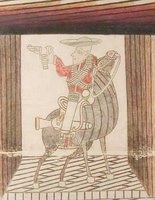
In his recent New Yorker review, Peter Schjeldahl offers some thoughtful points about Martín Ramírez and his [status] as an "outsider artist."
Outsider art—lately euphemized as “self-taught,” a vapid label that inconveniently describes originality in general—comes from and goes nowhere in art history. (The outsider is a culture of one.) It defeats normal criticism’s tactics of context and comparison. It is barbaric. Can we skirt the imbroglio and regard Ramírez as an ordinary artist with extraordinary qualities? Let’s see. ...Schjeldahl thoughts reflected some of my less collected ones of my own as I passed through this immensely engaging exhibit and especially as I considered the descriptive content accompanying his artwork.
One newspaper clipping on display described Ramírez as an "insane artist," so I guess "outsider artist" is a marked improvement on that nomenclature. One of his early exhibits was officially entitled "The Art of a Schizophrene," a reflection of his diagnosis at the time, which has more recently come under some doubt. Either way, it seems inhuman to advertise a talented artist in the manner of a sideshow barker. After all, Jackson Pollock's art wasn't advertised as "The Work of an Alcoholic."
Similarly Schjeldahl asks:
What is it like to be an outsider? Outside what? Ramírez worked cogently from within his memory, imagination, and talent. He also belonged to an actual culture, that of a mid-century American mental hospital.The NYT's Roberta Smith also asks just how "outside" was Ramírez:
If you revere outsider artists as pure, isolated, often insane visionaries who exist outside time and place, make way for a so-called outsider whose work reflected many of the specifics of his cultural and historic moment. In addition, Ramírez’s art was in step with the explorations of many “insider” artists of his time, especially in his use of collage and images from popular culture.As Schjeldahl explains, labels like "outsider" allow us to peg certain artists as supposedly existing outside the history of art. But how helpful is the label really when you consider the context of Ramírez's life and work?
Among the essays supporting the exhibit, one critic even described Ramírez as being "confined to the dustbin of history." I hope we won't dispatch Ramírez quite so quickly. There's still time for his reputation and influence to grow.
Or as Schjeldahl concludes:
What can we do with and about the rush of pleasure and enchantment that the unlicensed genius of a Ramírez affords? I recommend taking it as a lesson in the limits of how we know what we think we know. Unable to regard such work as part of art’s history, we may still have it be part of our own.
No comments:
Post a Comment